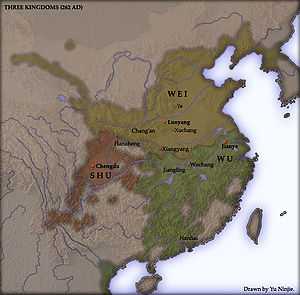Shu Roads

The Shu Roads (蜀道, Pinyin shǔdào) were a system of mountain roads joining the Chinese provinces of Shaanxi and Sichuan, built and maintained since the 4th century BC. Technical highlights were the gallery roads, consisted of wooden planks erected on holes cut into the sides of cliffs.
Geography
The roads joined three basins surrounded by mountains. The northern basin is called Guanzhong ("between the passes"). It is passed and drained bay the Yellow River. In old ages it was the heart of Qin state, nowadays it is the central region of Shaanxi. To the south it is limited by Qinling mountains. South of that range, there is the basin of Hanzhong, drained by the Han River, a tributary of Yangtze. By the ranges of Mǐcāng Shān (米倉山/米仓山, "Rice Granary Mountains") in the west and Daba Mountains in the east, it is divided from the Sichuan basin, passed and drained by the Yangtze River.
There were five roads across the Qinling Mountains, counted from west to east:
- Chencang Road (陈仓道) is named after the city of Chencang, literally "Old Granary".
- Baoye Road (褒斜道, Bāoyédào), often erroneously written "Baoxie Road",[1] is named after two rivers, called Bāoshuǐ (褒水, "Praised Water") and Yéshuǐ (斜水, "Queer Water"), nowadys called Shitou He (石头河).
- Tangluo Road (傥骆道, Tǎngluòdào) is named after the Camel Gorge (駱峪, Luòyù) in the north and Tangshui River (儻水河, Tǎngshuǐ Hé, "Unexpected Water River") in the south.
- Ziwu Road (子午道, Zǐwǔdào) is named after the township of 子午 "Midnight-Noon" or "Median". Its southern part and the junction to the main road of Hanzhong basin was moved from east to west, in two steps.
- Kugu Road (库谷道), named after the valley 库谷 (Kùgǔ, "Warehouse Dale") or 库峪 (Kùyù, "Warehouse Gorge"), reaches Han River it today's Xunyang County (旬阳), which afforded a rectangular turn west to reach the central part of Hanzhong Basin.
The Lianyun Road (连云道, Liányúndào, "Linking Road") connected the first two ones.
Between Hanzhong and the Sichuan basin, three main roads were built
- Jinniu Road (金牛道, Jīnniúdào, "Golden Ox Road") to Chengdu, the capital of Sichuan, in old ages capital of the Shu state.
- Micang Road (米仓道/米倉道, Mǐcāngdào, "Rice Granary Road); in the Basin south of Micang Mountains, two different clourses are suggested, one to Chengdu and one to Chungqing, nowadays the largest city of the Basin. The reason for this bias might be a bifurcation or temporal changes. In 4th and 3rd century AC, Chungqing had not yet been founded.
- Yàngbā (洋巴道) - or Lychee Road (荔枝道, Lìzhīdào), the easternmost road, ended east of Chongqing in Fuling (涪陵) on the Yangtze. This place was not situated in Shu State, but in neighbouring Ba federation. Today it belongs to the territory of Chongqing.
History


In 316 BC, the state of Qin, the capital of which was Xianyang (present day Xi'an), conquered Shu and its eastern neighbour, the Ba federation. Related to this conquest, the first roads were built through the mountains. Of the Golden Ox Road there is a tale, the ruler of Shu had built it in order to send the ruler of Qin a golden ox as a gift. so it is not impossible that this road was constructed by Shu. All other roads have been built by Qin State.
Time by time the sections not consisting of planks were plastered. Nevertheless they were a challenge for the travellers. One poet wrote about the "hard road to Shu", another about "ladders to heaven made of timber and stones". Along the roads fortified control posts and cities were built.

During two conflicts, parts of the plank roads were burned effigy: After the decay of Qin Dynasty in 206 BC, the successful leader of the revolt, Xiang Yu, banished his strongest rival, Liu Bang. Retreating with his army to Hanzhong, Liu destroyed all plank roads immediately after his passage, in order to stop any persecutor. Later he founded Han Dynasty. In peacetime, the mountain roads were rebuilt. Four hundred years later, in the age of the Three Kingdoms, Liu Bei, the founder of the state of Shu Han, again destroyed the plank roads. Afterwards they were restored again.
Marco Polo, who on his Asian journey (1271–1295) had spent the years 1275 to 1295 in China, described the Lianyun Road.
By time, China's centres of population and economy moved out of the western mountain regions to the eastern plains. The main flows of traffic switched in the same way. But the Shu Roads remained most important for the communication between the western basins.
During the quarrels in the end of Ming age, Sichuan suffered material damages and losses of population by various raids. Long sections of the Shu Roads fell in despair. Under the rule of the Qing Dynasty, Sichuan was rebuilt, and the Shu Roads as well. They remained important routes of traffic until the first decades of 20th century.
The first modern road to Sichuan was opened in 1937. On long sections the new roads were built on almost the same routes as the old ones. This way the ancient plank roads were destroyed. New plank roads were built for sightseeing tourists. They never served real traffic.
Sources/Weblinks
- Australia-China Cooperation, Shu Roads Project: China's Qinling Plank Roads to Shu
- 蜀道简介 Lists of places along Shu Roads, (in Chinese script)
- China's Great Roads – generally on ancient Chinese roads
- ↑ In other context and in standard dictionaries, the character 斜 is spelled xié, indeed:
• Langenscheidt Handwörterbuch Chinesisch
• Das Neue Chinesisch-Deutsche Wörterbuch, ISBN 7-100-00096-3